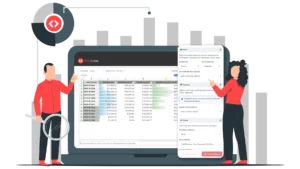Updated: February 13, 2024
In the dynamic world of vacation rentals, success hinges on adapting to market trends, understanding competitor strategies, and optimizing pricing strategies accordingly. Fortunately, property managers can monitor competitor prices for vacation rentals using powerful tools like price trackers for vacation rentals, which provide invaluable insights into market data and competitor analysis.
Let’s delve deeper into how vacation rental property managers can effectively leverage a price tracker on PriceLabs to gain a competitive edge. First, let’s discuss the features you can use to track your prices and competitors and conduct market analysis.
Monitor Competitor Prices for Vacation Rentals
Neighborhood Data Analysis
Neighborhood data is the foundation for effective pricing strategies in the vacation rental industry. It offers invaluable insights for vacation rental managers to monitor competitor prices for vacation rentals and enhance their pricing strategies. By accessing this feature, users can compare their listing prices, occupancy trends, and booking patterns with those of similar properties in the area.
Through detailed charts and data overlays, managers can identify average prices, occupancy rates, and booking trends, allowing them to adjust their pricing strategies accordingly.
For example, if a property manager notices that their listing prices are consistently higher than the market average during peak seasons, in that case, they may adjust their rates slightly to remain competitive while capitalizing on increased demand.
Monitoring Market Occupancy Trends
Understanding market occupancy trends is crucial for optimizing pricing strategies. Property managers can leverage PriceLabs’ Neighborhood Data and Market Dashboards to monitor occupancy levels in their target market and make data-driven decisions accordingly.
For instance, if a property manager observes a surge in demand for vacation rentals during a particular event or holiday season, they may adjust their pricing strategy to capitalize on the increased demand. They can also increase their minimum night restrictions to avoid booking gaps and maximize their profits. Conversely, managers may offer promotional rates during periods of low occupancy to attract more bookings and maximize occupancy rates.
Competitor Calendar in Neighborhood Data


The Competitor Calendar feature in PriceLabs allows vacation rental managers to compare their listings with up to 10 specific competitors in their neighborhood. By selecting listings and clicking “Get Calendar,” managers can view competitor rates with their listing prices displayed in bold. Unavailable dates are greyed out, crossed-out dates indicating estimated booked prices.
This tool provides valuable insights into competitor pricing strategies, enabling managers to monitor competitor prices for vacation rentals, adjust their pricing strategies accordingly, and stay competitive.
For example, if a property manager notices a competitor consistently undercutting their prices during peak seasons; in that case, they may choose to adjust their rates to remain competitive while maintaining profitability.
Hotel Price Tracker in Hotel Data
In addition to analyzing vacation rental listings, hoteliers can also leverage a price tracker to monitor hotel pricing trends in their area. The Hotel Price Tracker feature offered by PriceLabs provides comprehensive insights into nearby hotel pricing dynamics. Managers can select up to 350 hotels for comparison, with default selections being the nearest 10 hotels.
Utilizing Length of Stay (LOS) filters, managers can analyze pricing variations based on minimum stay criteria, helping to optimize pricing strategies. The tool offers both table and graph views, allowing for easy comparison of nightly rates among selected hotels. Additionally, the map view visually represents hotel locations, color-coded based on review scores.
This feature empowers managers to make informed decisions and stay competitive in the rental accommodation market.
For instance, if hotel prices in the area are significantly higher than vacation rental rates, hotel managers may adjust their pricing strategy to attract budget-conscious travelers looking for affordable lodging options.
How can Property Managers Use PriceLabs Features to Optimize their Pricing?
- Optimizing Pricing for Special Events: Property managers can use the price tracker to identify upcoming events or festivals in their area and adjust their pricing strategy accordingly.


For example, if a popular music festival occurs nearby, managers may choose to increase their rates and minimum length of stay to capitalize on the increased demand from festival-goers.
- Monitoring Competitor Strategies: By regularly monitoring competitor pricing for vacation rentals and availability through the price tracker, property managers can identify emerging trends and adjust their pricing strategy accordingly.
For instance, if a competitor starts offering discounted rates during off-peak seasons, managers may choose to match or undercut those prices to remain competitive. Conversely, if a competitor has dates already booked at a higher price than yours, then you can choose to increase your rates as there is demand at that price point.
Conclusion
Utilizing revenue management software like PriceLabs in the vacation rental industry is paramount for property managers seeking to stay competitive and maximize revenue. Through features such as Neighborhood Data Analysis, Market Occupancy Trends Monitoring, Competitor Calendar, and Hotel Price Tracker, managers can gain invaluable insights into market dynamics, competitor strategies, and seasonal demand patterns.
By leveraging these features effectively, managers can make data-driven decisions to optimize pricing strategies, capitalize on peak demand periods, and attract more bookings. Ultimately, embracing technology-driven solutions like PriceLabs empowers property managers to adapt to market trends swiftly, enhance their competitiveness, and achieve greater success in the dynamic world of vacation rentals.
About PriceLabs
PriceLabs is a revenue management solution for the short-term rental and hospitality industry, founded in 2014 and headquartered in Chicago, IL. Our platform helps individual hosts and hospitality professionals optimize their pricing and revenue management, adapting to changing market trends and occupancy levels.
With dynamic pricing, automation rules, and customizations, we manage pricing and minimum-stay restrictions for any portfolio size, with prices automatically uploaded to preferred channels such as Airbnb, Vrbo, and 100+ property management systems and channel integrations.
Every day, we price over 300,000+ listings globally across 135+ countries, offering world-class tools like the Base Price Help and Minimum Stay Recommendation Engine. Choose PriceLabs to increase revenue and streamline pricing and revenue management. Sign up for a free trial at pricelabs.co today.







